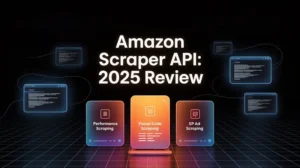The Current Situation and Challenges of Public Network Data Scraping
In the current digital age, the public network undoubtedly serves as an important carrier for information exchange and data circulation. However, due to the complexity and dynamics of the network environment, individuals and organizations that need to scrape data from the web face many challenges. Common challenges include anti-scraping mechanisms on websites, diverse data formats, and network access restrictions, all of which hinder efficient data scraping.
Data Security and Privacy Protection:
Public network data faces increasing security threats such as cyber attacks and data breaches. Ensuring data security and privacy protection is a crucial challenge. Governments and organizations need to take effective measures, including encryption, access control, and authentication, to protect data from unauthorized access and misuse.
Meanwhile, with the increase in personal data and digitalization, privacy protection has become an increasingly prominent issue. Finding a balance between data utilization and privacy protection is a major challenge in public network data management.
Data Quality:The quality of public network data directly affects the accuracy of data analysis and decision-making. Data quality issues may include incompleteness, inaccuracy, inconsistency, etc. Therefore, ensuring data quality is an important challenge. This requires measures such as data cleansing, standardization, and validation to improve data quality.
Data Governance:Data governance involves managing the rules, policies, and processes of data to ensure its legality, availability, security, and reliability. Establishing an effective data governance framework is an important measure to safeguard public network data management, but it is also a complex challenge. Issues such as data ownership, data access permissions, and data usage rules need to be considered.
Open Data Sharing:Open data sharing can promote innovation and economic development, but it also involves many challenges. These include the scope of data openness, methods of openness, and restrictions on data usage. In addition, open data sharing also needs to consider issues such as privacy protection and data security.
Technological Infrastructure:The storage, transmission, and processing of public network data rely on various technological infrastructures, including cloud computing, big data technologies, artificial intelligence, etc. Establishing robust and efficient technological infrastructure is an important prerequisite for ensuring public network data management but is also a challenge that requires continuous investment and updates.
In summary, public network data faces many challenges, including security and privacy, data quality, data governance, open sharing, and technological infrastructure. Effectively addressing these challenges requires joint efforts from governments, businesses, and society through policies, strengthened technological innovation, and enhanced international cooperation to promote the development of public network data management.
From Initial Request to Final Analysis: The Real Process of Web Data Projects
In web data scraping projects, it typically involves the following key stages: determining data requirements -> designing scraping strategies -> building scraping systems -> deployment -> data cleansing and processing -> data analysis and application. Among these, designing efficient scraping strategies, developing robust scraping systems, and handling diverse data formats are critical and challenging. A typical web data project usually includes the following steps:
Defining project goals and scope:Firstly, the team needs to clearly define the project’s goals and scope. This may involve determining the types of data to be collected, analysis focus, project timelines, and budgets.
Data collection:Once the project’s goals and scope are defined, data collection needs to begin. Data can come from various sources, including website access logs, APIs, social media platforms, surveys, etc. At this stage, it’s essential to ensure the legality and accuracy of data collection.
Data cleansing and preprocessing:The collected raw data often contains various issues such as missing values, outliers, duplicate data, etc. Therefore, before actual analysis, data need to be cleansed and preprocessed. This may involve operations like data cleaning, deduplication, filling missing values, data transformation, etc., to ensure data quality and consistency.
Data storage and management:Processed data needs to be stored properly and effectively managed. This may include establishing databases, data warehouses, or using cloud storage services to ensure data security and availability.
Data analysis:Once the data is prepared, actual data analysis can be performed. This may involve using various statistical methods, machine learning algorithms, data visualization tools, etc., to discover patterns, trends, and correlations in the data, to achieve the analysis goals set for the project.
Interpreting and presenting results:After analysis, results need to be interpreted and presented to relevant stakeholders. This may include writing reports, creating data visualization charts, giving presentations, etc., to ensure that results are understood and accepted and to provide support for decision-making.
Adjustment and optimization:Finally, based on feedback and evaluation results, adjustments and optimizations may be required in the analysis process. This may involve re-collecting data, improving analysis methods, updating models, etc., to continually enhance the project’s effectiveness and value.
Throughout the process, close collaboration within the team is necessary to ensure smooth progress at each step and ultimately achieve the project’s goals. Additionally, continuous attention to data security and privacy protection is essential to ensure the project’s legality and credibility.
From Click to Capture: Mastering Browser Interactive Data Scraping
For some websites with complex interactions, traditional web scrapers may fall short, requiring the simulation of browser interactions to obtain the desired data. This demands data scraping tools with convenient browser interaction capabilities, capable of automating various operations such as clicks, inputs, scrolling, etc., and flexibly bypassing anti-scraping mechanisms.
Identifying data requirements:Firstly, identify the types and content of data needed to be scraped. This may include page views, click events, user behaviors, etc. Based on project requirements, clarify the data indicators and details to be scraped.
Deploying tracking codes:To achieve data scraping, tracking codes need to be deployed on the website or application. Typically, tracking codes provided by web analytics tools (such as Google Analytics, Adobe Analytics, etc.) are used. These codes are usually JavaScript code snippets that can be inserted into the HTML of web pages.
Capturing user interaction events:Through tracking codes, various user interaction events, such as page views, link clicks, form submissions, etc., can be captured. When users interact with web pages, the tracking codes trigger corresponding events and send relevant data to the analytics server for processing.
Data transmission and processing:Once user interaction events are captured, data is typically sent to the analytics server via HTTP requests. On the server side, specialized data processing tools or services can be used to parse and process this data. These tools can extract useful information such as page URLs, user identifiers, event types, etc., and store them in databases or data warehouses.
Data analysis and visualization:Data stored in databases or data warehouses can be used for data analysis and visualization. By using statistical methods, data mining techniques, etc., patterns, trends, and correlations in the data can be discovered. Additionally, data visualization tools (such as charts, reports, dashboards, etc.) can be used to visually present analysis results.
Optimization and improvement:Based on the results of data analysis, website or application optimization and improvement may be necessary. This may involve modifying page designs, adjusting user interfaces, improving content strategies, etc., to enhance user experience and website performance.
Privacy protection and compliance:During data scraping and analysis, attention needs to be paid to protecting user privacy and ensuring compliance with relevant laws, regulations, and privacy policies. Measures may include anonymizing sensitive data, obtaining user consent, providing data access rights, etc.
The entire process requires close attention to data accuracy, completeness
Data Scraping with Pangolin‘s Scrape API
Pangolin’s Scrape API is a data scraping tool designed to assist users in extracting data from the internet and providing a simple and user-friendly API interface. Below are the main features and usage of this product:
Data Scraping:The Scrape API allows users to specify target websites to scrape and the data they need to extract. Users can define scraping rules such as selecting pages to scrape and extracting specific content or elements.
Customized Scraping Rules, including Postal Zone Scraping:Users can define scraping rules through simple configuration without the need for complex coding. This enables non-technical users to easily use the tool for data scraping. The process involves data scraping based on specified postal zone ranges. In web data scraping, there is sometimes a need to collect data for specific geographic areas to meet specific requirements or goals. Specifying postal zone scraping is often used to retrieve location-related information such as business listings, geographical information, traffic routes, etc., from websites or online map services.
Real-time Data Updates:The Scrape API offers real-time data update functionality, allowing for periodic scraping of data from target websites and providing updated data through the API interface.
Multiple Output Formats:Scraped data can be outputted in various common formats such as JSON, CSV, XML, etc., facilitating subsequent data processing and analysis by users.
Automation Tasks:Users can set up automation tasks to perform data scraping and updating operations regularly. This ensures that data remains up-to-date and reduces manual workload.
Proxy Support:During data scraping, the Scrape API supports the use of proxy servers to ensure the stability and reliability of the scraping process. This is particularly useful for handling large amounts of data or scraping from websites with strict limitations.
Scalability:The Scrape API is highly scalable, allowing for custom development and integration according to user needs. Users can expand and customize data scraping functionality based on their business requirements.
In summary, Pangolin’s Scrape API product provides a simple yet powerful data scraping tool that enables users to easily collect data from the internet and access and use it conveniently through the API interface. Compared to other competitors, Pangolin’s browser interaction features are richer and more flexible, effectively addressing most complex scenarios.
With the continuous development of AI technology, building high-quality training datasets is a crucial prerequisite for ensuring AI model performance. However, during the data collection process, legal issues such as privacy and copyright are inevitably involved, posing challenges to data operations. In the future, data operation teams will need to strike a balance between data quality, compliance, and efficiency and formulate corresponding strategies.
Privacy Protection and Data Security:With the advancement of AI technology and the massive collection of data, privacy protection and data security have become important legal and operational challenges. The use of AI data must comply with privacy regulations and data protection standards such as GDPR (General Data Protection Regulation) and CCPA (California Consumer Privacy Act). Effective measures need to be taken to protect data from unauthorized access and misuse to ensure data security and credibility.
Data Governance and Compliance:Data governance is an essential means of ensuring data quality, reliability, and availability. In the use of AI data, it is necessary to establish an effective data governance framework, clarify data ownership, usage rules, and access permissions, and ensure data compliance. This involves developing and implementing relevant policies, processes, and technical measures to protect the legality and credibility of data.
Transparency and Accountability:The use of AI data needs to maintain transparency and clarify responsibilities and obligations. Users and stakeholders need to understand the sources, processing methods, and purposes of data and be able to trace the flow and use of data. Meanwhile, data users need to be responsible for the legality and accuracy of the data and bear corresponding legal responsibilities.
Open Data Sharing and Innovation:Promoting open data sharing and innovation is an important legal and operational challenge under the premise of protecting privacy and data security. Open data sharing can promote innovation and economic development, but it also needs to consider issues such as privacy protection and data security. Therefore, corresponding policies and legal frameworks need to be formulated to balance the relationship between open data sharing and privacy protection.
International Cooperation and Standardization:Given the characteristics of data cross-border flow, international cooperation and standardization are crucial. Countries can strengthen cooperation, jointly formulate and implement data protection regulations and standards to protect global data security and privacy. At the same time, international data exchange and cooperation need to be strengthened to promote open data sharing and innovation.
From AI-Driven Insights to Training LLM: Mastering Data Set Construction for AI Use Cases
To support different AI use cases, it is necessary to build corresponding datasets tailored to the specific tasks. For example, for natural language processing, a variety of language samples need to be covered; for computer vision tasks, a large amount of annotated image datasets are required; for recommendation systems and other scenarios, relevant interaction data need to be collected. In general, step-by-step construction of datasets that meet the training needs of AI models is key according to the specific requirements of each scenario.
Clarifying Goals and Requirements:Firstly, it is necessary to clarify the AI use case and specific tasks for which the dataset needs to be built. For example, is it for natural language processing, computer vision, recommendation systems, or other types of tasks? For each task, considerations include different data types, data volumes, data quality, etc.
Data Collection:Based on the goals and requirements, start collecting relevant data. For natural language processing tasks, it may be necessary to collect text data in various languages; for computer vision tasks, a large number of image datasets may be required; for recommendation systems and other scenarios, user behavior data or product information need to be collected.
Data Cleaning and Annotation:The collected raw data often has various issues such as noise, inconsistency, missing values, etc. Therefore, data cleaning and annotation are necessary. This may include removing duplicate data, filling in missing values, correcting errors, etc., to ensure data quality and consistency.
Data Partitioning:Divide the dataset into training, validation, and testing sets, etc. The training set is used for model training, the validation set is used for model tuning and selecting hyperparameters, and the testing set is used for evaluating the model’s performance and generalization ability.
Data Augmentation:Data augmentation is a commonly used technique to increase the diversity of data by transforming and expanding the original data. For example, in computer vision tasks, images can be rotated, cropped, scaled, etc., to generate more training samples.
Continuous Updates and Optimization:As models are continuously trained and applied, it may be discovered that there are issues in the dataset or new requirements arise. Therefore, continuous updates and optimization of the dataset are needed to ensure that it effectively supports model training and application.
In conclusion, for different AI use cases, step-by-step construction of datasets that meet the specific task requirements and scenario characteristics is crucial. This includes processes such as data collection, cleaning and annotation, partitioning datasets, data augmentation, etc., which need to be continuously optimized and updated to ensure dataset quality and applicability.
Blueprint for Building Reliable Datasets: Schema, Validation, and Quality Assurance
Regardless of the method used to construct datasets, attention must be paid to data quality. Firstly, it is important to clarify the structured schema of the data and define a unified format. Secondly, a data validation process needs to be established to promptly identify and address anomalies. Furthermore, it is necessary to introduce automated or manual quality inspection mechanisms to ensure the overall quality of the dataset. Only by ensuring the accuracy, completeness, and consistency of the dataset can a reliable data foundation be provided for AI model training.
In general, web data scraping and AI dataset construction are challenging yet extremely important fields. In the future, with the thriving development of AI technology, the demand for high-quality datasets will continue to grow. Only by mastering advanced data scraping and processing techniques and adhering to compliance and quality can one navigate steadily in the wave of artificial intelligence.
Defining Data Schema:Data schema is a specification that describes the structure, types, and constraints of data. Defining data schema helps ensure data consistency and understandability. Before constructing a dataset, it is necessary to clearly define the data schema, including data fields, data types, value ranges, relationships, etc. This can be achieved through the use of data schema languages (such as JSON Schema, Avro Schema) or database table structures.
Data Scraping and Cleaning:During the data scraping phase, raw data needs to be collected and cleaned. The data cleaning and preprocessing process involve operations such as removing duplicate data, handling missing values, correcting errors, and converting data types to ensure data quality and consistency.
Data Validation:Data validation is the process of ensuring that data conforms to the expected pattern and specification. After data scraping and cleaning, data validation is necessary to ensure that the data conforms to the defined data schema. This may include verifying data types, ranges, completeness, consistency, etc. If the data does not conform to the expected pattern, further cleaning and processing may be required.
Data Quality Assurance:Data quality assurance is the process of ensuring the accuracy, completeness, reliability, and consistency of data. After data scraping, cleaning, and validation, data quality assessment and monitoring are necessary to promptly identify and address data quality issues. This may include establishing data quality metrics, monitoring changes in data quality, and formulating data quality strategies.
Continuous Improvement and Optimization:Data quality assurance is a continuous improvement process. It is necessary to regularly assess and optimize the data quality assurance process, adjust and improve methods and tools for data scraping, cleaning, validation, and monitoring to ensure that the dataset maintains high quality.
In summary, the blueprint for building reliable datasets needs to consider aspects such as defining data schema, data scraping and cleaning, data validation, and data quality assurance. By establishing an effective data quality assurance process, the quality and reliability of the dataset can be ensured, providing a reliable foundation for subsequent data analysis and applications.
Summary of Web Data Scraping
In the process of building reliable datasets, we emphasize key steps such as defining data schema, data scraping and cleaning, data validation, and data quality assurance. These steps form the basis for ensuring dataset quality and reliability, which are crucial for supporting AI model training and application. However, achieving these steps is not easy and requires comprehensive consideration of various factors and effective measures to ensure data quality and consistency.
In this process, the Scrape API product can provide you with a convenient and efficient data scraping solution. Through Scrape API, you can easily scrape data from the internet and access and use this data through a simple and user-friendly API interface. Whether you are working on natural language processing, computer vision, recommendation systems, or other types of tasks, the Scrape API can help you quickly obtain the data you need, thereby accelerating your project progress and improving work efficiency.
Therefore, we encourage you to try using the Scrape API product, experience its powerful features and convenient operation. Let the Scrape API be your powerful assistant in building reliable datasets and supporting AI model training, paving the way for the success of your projects.







